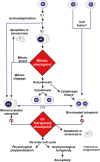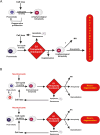Tetraploidy in normal tissues and diseases: mechanisms and consequences
- PMID: 40117022
- PMCID: PMC11928420
- DOI: 10.1007/s00412-025-00829-1
Tetraploidy in normal tissues and diseases: mechanisms and consequences
Abstract
Tetraploidisation plays a crucial role in evolution, development, stress adaptation, and disease, but its beneficial or pathological effects in different tissues remain unclear. This study aims to compare physiological and unphysiological tetraploidy in eight steps: 1) mechanisms of diploidy-to-tetraploidy transition, 2) induction and elimination of unphysiological tetraploidy, 3) tetraploid cell characteristics, 4) stress-induced unphysiological tetraploidy, 5) comparison of physiological vs. unphysiological tetraploidy, 6) consequences of unphysiological stress-induced tetraploidy, 7) nutritional or pharmacological prevention strategies of tetraploidisation, and 8) knowledge gaps and future perspectives. Unphysiological tetraploidy is an adaptive stress response at a given threshold, often involving mitotic slippage. If tetraploid cells evade elimination through apoptosis or immune surveillance, they may re-enter the cell cycle, causing genetic instability, micronuclei formation, aneuploidy, modification of the epigenome and the development of diseases. The potential contributions of unphysiological tetraploidy to neurodegenerative, cardiovascular and diabetes related diseases are summarized in schematic figures and contrasted with its role in cancer development. The mechanisms responsible for the transition from physiological to unphysiological tetraploidy and the tolerance to tetraploidisation in unphysiological tetraploidy are not fully understood. Understanding these mechanisms is of critical importance to allow the development of targeted nutritional and pharmacological prevention strategies and therapies.
Keywords: Cardiovascular; Diabetes; Neurodegenerative; Physiological tetraploidy; Tetraploidy; Unphysiological tetraploidy.
© 2025. The Author(s).
Conflict of interest statement
Declarations. Ethical Approval: Clinical trial number: not applicable. Conflict of interest: The authors declare no competing interests.
Figures






Similar articles
-
A rapid and systematic review of the clinical effectiveness and cost-effectiveness of paclitaxel, docetaxel, gemcitabine and vinorelbine in non-small-cell lung cancer.Health Technol Assess. 2001;5(32):1-195. doi: 10.3310/hta5320. Health Technol Assess. 2001. PMID: 12065068
-
Interventions for promoting habitual exercise in people living with and beyond cancer.Cochrane Database Syst Rev. 2018 Sep 19;9(9):CD010192. doi: 10.1002/14651858.CD010192.pub3. Cochrane Database Syst Rev. 2018. PMID: 30229557 Free PMC article.
-
Behavioral interventions to reduce risk for sexual transmission of HIV among men who have sex with men.Cochrane Database Syst Rev. 2008 Jul 16;(3):CD001230. doi: 10.1002/14651858.CD001230.pub2. Cochrane Database Syst Rev. 2008. PMID: 18646068
-
A rapid and systematic review of the clinical effectiveness and cost-effectiveness of topotecan for ovarian cancer.Health Technol Assess. 2001;5(28):1-110. doi: 10.3310/hta5280. Health Technol Assess. 2001. PMID: 11701100
-
AGA Clinical Practice Update on GI Manifestations and Autonomic or Immune Dysfunction in Hypermobile Ehlers-Danlos Syndrome: Expert Review.Clin Gastroenterol Hepatol. 2025 Jul;23(8):1291-1302. doi: 10.1016/j.cgh.2025.02.015. Epub 2025 May 19. Clin Gastroenterol Hepatol. 2025. PMID: 40387691 Review.
Cited by
-
Hepatocytes as Model for Investigating Natural Senotherapeutic Compounds and Their Effects on Cell Cycle Dynamics and Genome Stability.Int J Mol Sci. 2025 Jul 16;26(14):6794. doi: 10.3390/ijms26146794. Int J Mol Sci. 2025. PMID: 40725041 Free PMC article. Review.
References
-
- Antonelli Y, Krüger R, Buehler A, Monavari M, Fuentes-Chandía M, Colombo F, Palmisano R, Boßerhoff AK, Kappelmann-Fenzl M, Schödel J, Boccaccini AR (2024) When mechanical stress matters: generation of polyploid giant cancer cells in tumor-like microcapsules. Adv Funct Mater 34(35):2311139
Publication types
MeSH terms
LinkOut - more resources
Full Text Sources
Medical

